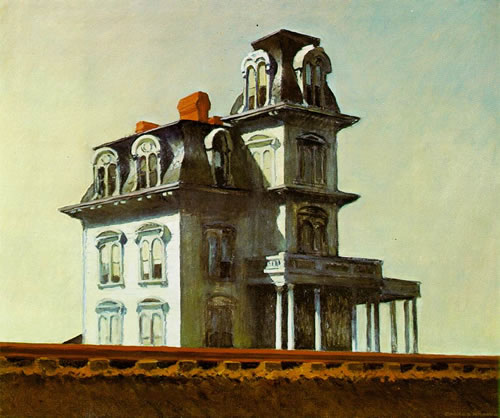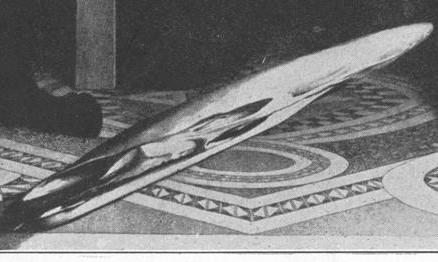Eliminative naturalism
Sat. August 1, 2009Categories: Abstract Dynamics

Dick-Disneyland-Dysphoria-Desertification
Dick’s Time Out Of Joint, published in 1959, two years after the first Disneyland park opened, is remarkable for the way in which it treats literary realism as a kind of Disneyfication. In a classic moment of Dick ontological vertigo, the novel’s painstakingly described small town is revealed, in the end, to be an intricate system of pasteboard frontages, hypnotic suggestions and negative hallucinations. The pay-off can just as easily be read in terms of critical metafiction as science fiction, for what is any setting in realist fiction if not the same kind of system? How is any ‘reality effect’ achieved except by authors using techniques such as these?
In the novel, the whole small town scenario is constructed as a pretext, a comfortable setting in which the protagonist can undertake high pressure military work for the goverment while thinking that he is doing a trivial newspaper contest. Yet it is clear that the science fictional elements were for Dick the pretext that allowed him to write successfully in a naturalistic way about 50s America. They were the enframing devices that enabled Time Out Of Joint to succeed where Dick’s purely realist fiction failed.
In Postmodernism, Jameson captures the peculiar ache of nostalgia that Time Out Of Joint engenders, a nostalgia for the present, which Dick achieves by constellating stereotypical images of the decade he was writing at the end of: “President Eisenhower’s stroke; Main Street, U.S.A.; Marilyn Monroe; a world of neighbours and PTAs; small retail stores (the produce trucked in from outside); favourite television programmes; mild flirtations with the housewife next door; game shows and contests; sputniks directly revolving overhead, mere blinking lights in the firmament, hard to distinguish from airliners or flying saucers.” (Monroe actually features as one of the ontological anomalies that leads to the unravelling of the simulated small town, for she has not been incorporated into the reconstructed 1950s world, and appears to the main character only when he discovers some rotting magazines, relics of the real 50s, in wasteground “outside the city limits”.)
What is remarkable is the way in which Dick was capable, in 1959, of already identifying those stereotypical features of the American 50s which would come to define the decade in retrospect. It is not Dick’s skill in projecting into the future that is to be admired – the novel’s 1997 is confected out of generic SF tropes, far less convincing than the ostensibly fake fifties world it embeds – but rather his capacity to imagine how the future would see the 50s. It is the 50s already envisaged as a themepark; an anticipated reconstruction. Dick’s simulated smalltown is not enkitsched as Disney’s memories of his early 20th century were, but precisely given what Jameson calls the “cabbage stink” of naturalism: “the misery of happiness, … of Marcuse’s false happpiness, the gratifications of the new car, the TV dinner and your favourite programme on the sofa – which are now themselves secretly a misery, an unhappiness that doesn’t know its name, that has no way of telling itself apart from genuine satisfaction and fulfilment since it has presumably never encountered this last.” In this lukewarm world, ambient dysphoria hides in plain view, a hazy malaise given off by the refrigerators, television sets and other consumer durables.
Jameson claims that “only Dick … comes to mind as the virtual poet laureate of this material: of squabbling couples and marital dramas, of petit bourgeois shopkeepers, neighbourhoods, and afternoons in front of the television, and all the rest.” Actually, Highsmith is another pulp poet laureate of the same impasses of 50s America, and Time Out Of Joint is very close to the cafes, suburban swimming pools and bitter marital deadlocks of This Sweet Sickness, Deep Water or The Blunderer. These naturalist impasses in Dick and Highsmith are invariably subsumed into a psychotic evacuation of the Symbolic. What initially seem to be merely slight deficiencies or excesses in the reality system inevitably turn out to be massive and irreperable cracks; and the pulp elements in Highsmith and Dick essentially amount to the authors’ ultimate identification with the psychotic perspective, with the gaping void of the Real.

House on the borderland of Psychoville? Edward Hopper’s House By The Railroad
Some of Dick’s most powerful passages are those in which there is an ontological interrugnum: a traumatic unworlding is not yet given a narrative motivation; a unresolved space that awaits reincorporation into another Symbolic regime. In Time Out Of Joint, the interregnum takes the form of an extraordinary scene in which the seemingly dull objects of quotidian naturalism – the gas station and the motel – act almost like a negative version of the lamp-post at the edge of the Narnian forest. Unlike Lewis’s lamp-post, these objects do not mark the threshold of a new world, a new Symbolic system; they constitute instead staging posts on the way towards the desert of the Real. When the edge of town gas stations come into focus, the background furniture of literary realism suddenly looms into the foreground, and there is a moment of Harmanian object-epipany, in which ready-to-hand, peripheral vision-familiarity transforms into uncanny opacity:
- The houses became fewer. The truck passed gas stations, tawdry cafes, ice cream stands and motels. The dreary parade of motels … as if, Ragle thought, we had already gone a thousand miles and were just now entering a strange town. Nothing is so alien, so bleak and unfriendly, as the strip of gas stations – cut-rate gas stations – and motels at the edge of your own city. You fail to recognise it. And, at the same time, you have to grasp it to your bosom. Not just for one night, but for as long as you intend to live where you live.
But we don’t intend to live here any more. We’re leaving. For good.
It’s a scene in which Edward Hopper seems to devolve into Beckett, as the natural(ist) landscape gives way to an emptied out monotony, a minimal, quasi-abstract space that is depeopled but still industrialized and commercialised. Beyond capitalist realism, the Real desert of Capital. “A last intersection, a minor road serving industries that had been zoned out of the city proper. The railroad tracks…he noticed an infinitely long freight train at rest. The suspended drums of chemicals on towers over factories.” “Fields, rolling hills, everything featureless, with advertising signs stuck at intervals.”
Here, in this no man’s land at the edge of naturalist form, we are close to the process described by Alex: “the betrayal of every prior world, and desertification… but where the desert itself, the absolute plane
is absent, though the process
continues
the desert is a mirage, but the dust
the dust is real.” An epigram perfect for Dick’s eliminative naturalism, that: “the desert is a mirage, but the dust is real.”
- Hollow outward form instead of substance; the sun not actually shining, the day not actually warm at all but cold, grey and quietly raining, raining, the god-awful ash filtering down on everything. No grass except charred stumps, broken off. Pools of contaminated water…
The skeleton of life, white brittle scarecrow support in the shape of a cross. Grinning. Space instead of eyes. The whole world … can be seen through. I am on the inside looking out. Peeking through a crack and seeing – emptiness. Looking into its eyes.
